Report: Information System Analysis for UniSA Stakeholders
VerifiedAdded on 2020/04/21
|12
|4996
|39
Report
AI Summary
This report presents an analysis of the existing information system at the University of South Australia (UniSA), evaluating its effectiveness and identifying key issues. The study examines the university's organizational structure, value chain using Porter's model, and competitive strategy, employing Porter's five forces. It investigates the human activity system, pinpointing problems related to the admission process and other stakeholder interactions. The report includes a rich picture and a BPMN process model to visualize the system's complexities. Furthermore, the DeLone-McLean model is applied to assess the system's success, focusing on information, system, and service quality. The analysis aims to improve efficiency, efficacy, and effectiveness within the university's operations, ultimately suggesting enhancements to the information system to better serve stakeholders.
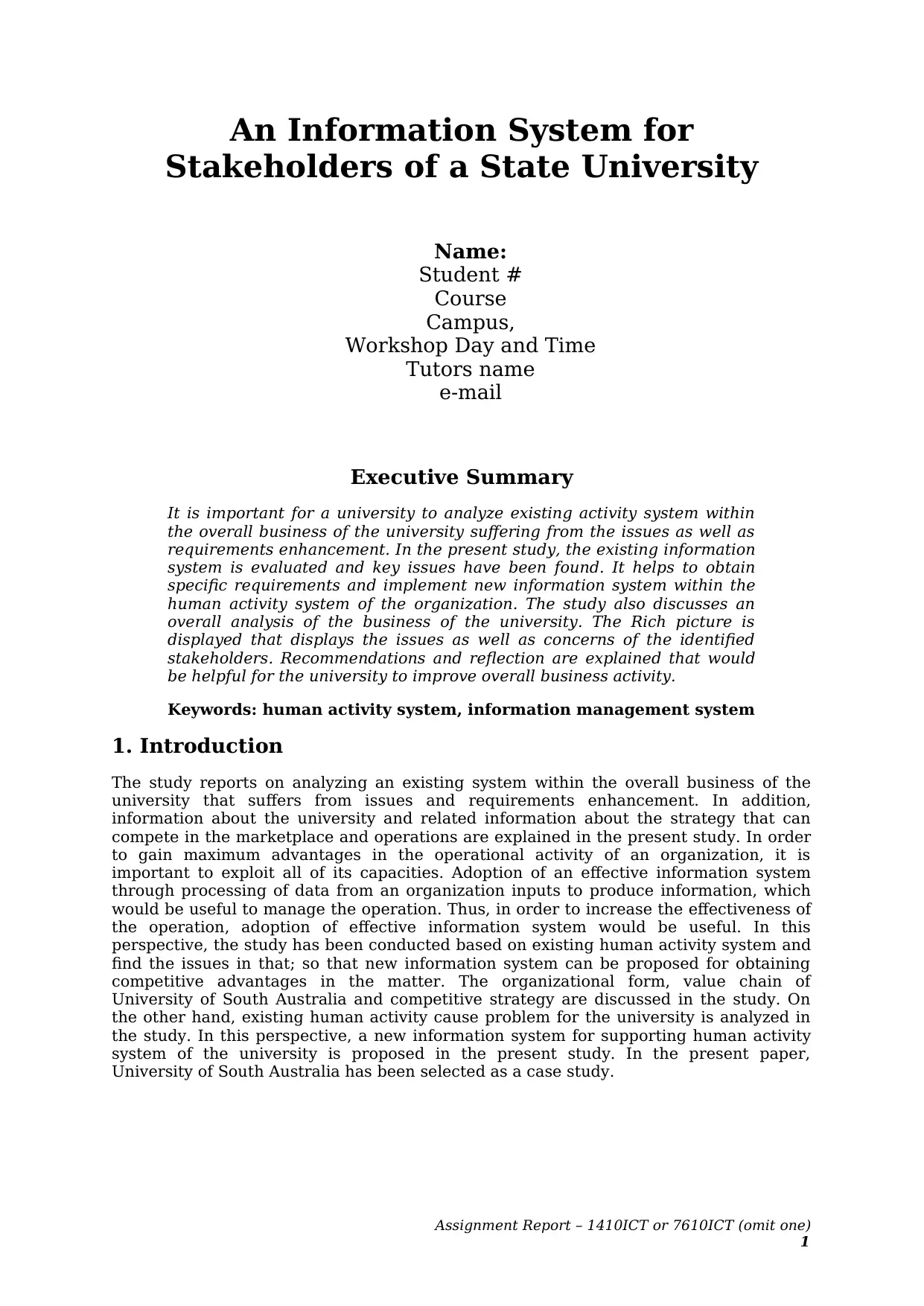
An Information System for
Stakeholders of a State University
Name:
Student #
Course
Campus,
Workshop Day and Time
Tutors name
e-mail
Executive Summary
It is important for a university to analyze existing activity system within
the overall business of the university suffering from the issues as well as
requirements enhancement. In the present study, the existing information
system is evaluated and key issues have been found. It helps to obtain
specific requirements and implement new information system within the
human activity system of the organization. The study also discusses an
overall analysis of the business of the university. The Rich picture is
displayed that displays the issues as well as concerns of the identified
stakeholders. Recommendations and reflection are explained that would
be helpful for the university to improve overall business activity.
Keywords: human activity system, information management system
1. Introduction
The study reports on analyzing an existing system within the overall business of the
university that suffers from issues and requirements enhancement. In addition,
information about the university and related information about the strategy that can
compete in the marketplace and operations are explained in the present study. In order
to gain maximum advantages in the operational activity of an organization, it is
important to exploit all of its capacities. Adoption of an effective information system
through processing of data from an organization inputs to produce information, which
would be useful to manage the operation. Thus, in order to increase the effectiveness of
the operation, adoption of effective information system would be useful. In this
perspective, the study has been conducted based on existing human activity system and
find the issues in that; so that new information system can be proposed for obtaining
competitive advantages in the matter. The organizational form, value chain of
University of South Australia and competitive strategy are discussed in the study. On
the other hand, existing human activity cause problem for the university is analyzed in
the study. In this perspective, a new information system for supporting human activity
system of the university is proposed in the present study. In the present paper,
University of South Australia has been selected as a case study.
Assignment Report – 1410ICT or 7610ICT (omit one)
1
Stakeholders of a State University
Name:
Student #
Course
Campus,
Workshop Day and Time
Tutors name
Executive Summary
It is important for a university to analyze existing activity system within
the overall business of the university suffering from the issues as well as
requirements enhancement. In the present study, the existing information
system is evaluated and key issues have been found. It helps to obtain
specific requirements and implement new information system within the
human activity system of the organization. The study also discusses an
overall analysis of the business of the university. The Rich picture is
displayed that displays the issues as well as concerns of the identified
stakeholders. Recommendations and reflection are explained that would
be helpful for the university to improve overall business activity.
Keywords: human activity system, information management system
1. Introduction
The study reports on analyzing an existing system within the overall business of the
university that suffers from issues and requirements enhancement. In addition,
information about the university and related information about the strategy that can
compete in the marketplace and operations are explained in the present study. In order
to gain maximum advantages in the operational activity of an organization, it is
important to exploit all of its capacities. Adoption of an effective information system
through processing of data from an organization inputs to produce information, which
would be useful to manage the operation. Thus, in order to increase the effectiveness of
the operation, adoption of effective information system would be useful. In this
perspective, the study has been conducted based on existing human activity system and
find the issues in that; so that new information system can be proposed for obtaining
competitive advantages in the matter. The organizational form, value chain of
University of South Australia and competitive strategy are discussed in the study. On
the other hand, existing human activity cause problem for the university is analyzed in
the study. In this perspective, a new information system for supporting human activity
system of the university is proposed in the present study. In the present paper,
University of South Australia has been selected as a case study.
Assignment Report – 1410ICT or 7610ICT (omit one)
1
Paraphrase This Document
Need a fresh take? Get an instant paraphrase of this document with our AI Paraphraser
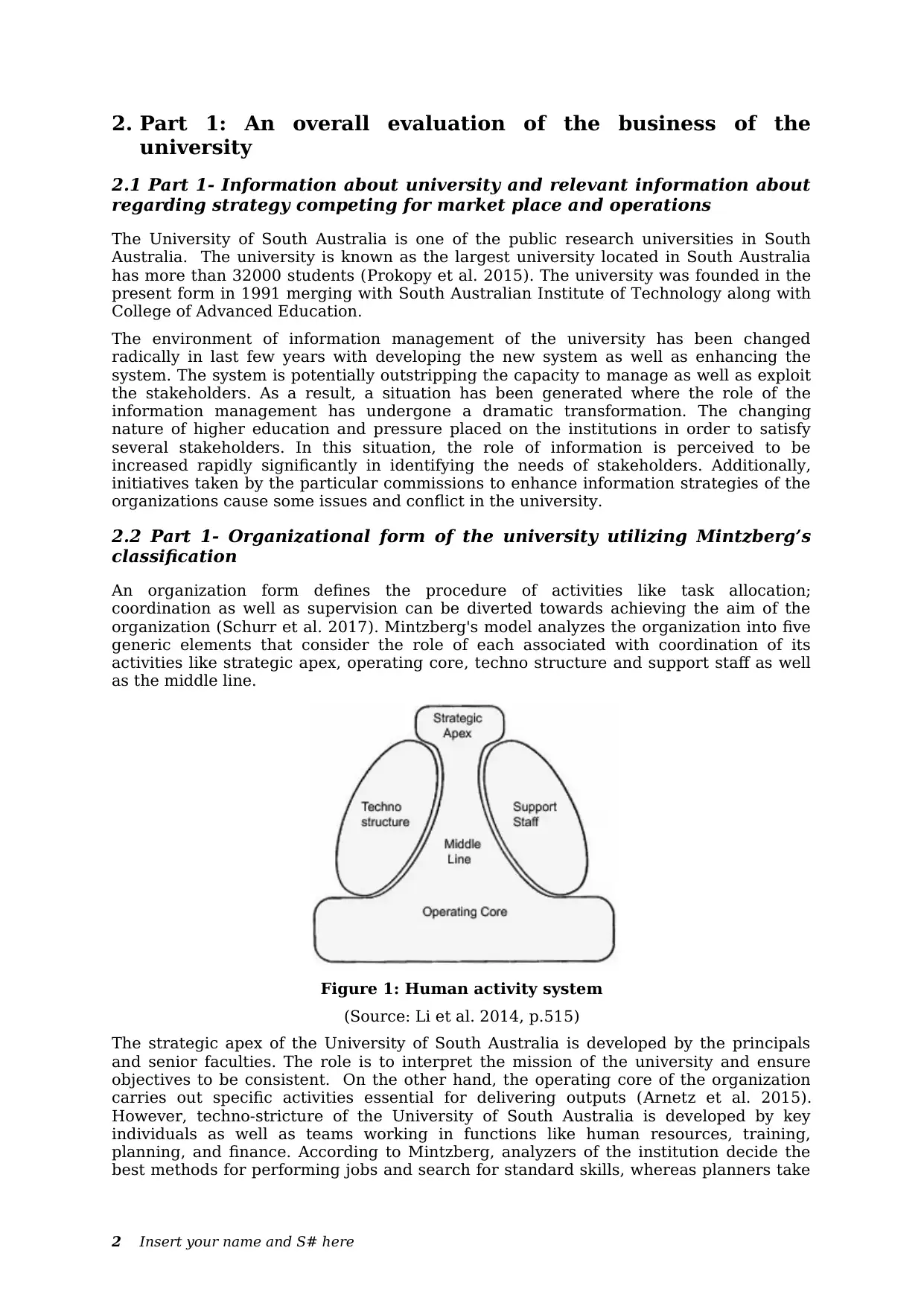
2. Part 1: An overall evaluation of the business of the
university
2.1 Part 1- Information about university and relevant information about
regarding strategy competing for market place and operations
The University of South Australia is one of the public research universities in South
Australia. The university is known as the largest university located in South Australia
has more than 32000 students (Prokopy et al. 2015). The university was founded in the
present form in 1991 merging with South Australian Institute of Technology along with
College of Advanced Education.
The environment of information management of the university has been changed
radically in last few years with developing the new system as well as enhancing the
system. The system is potentially outstripping the capacity to manage as well as exploit
the stakeholders. As a result, a situation has been generated where the role of the
information management has undergone a dramatic transformation. The changing
nature of higher education and pressure placed on the institutions in order to satisfy
several stakeholders. In this situation, the role of information is perceived to be
increased rapidly significantly in identifying the needs of stakeholders. Additionally,
initiatives taken by the particular commissions to enhance information strategies of the
organizations cause some issues and conflict in the university.
2.2 Part 1- Organizational form of the university utilizing Mintzberg’s
classification
An organization form defines the procedure of activities like task allocation;
coordination as well as supervision can be diverted towards achieving the aim of the
organization (Schurr et al. 2017). Mintzberg's model analyzes the organization into five
generic elements that consider the role of each associated with coordination of its
activities like strategic apex, operating core, techno structure and support staff as well
as the middle line.
Figure 1: Human activity system
(Source: Li et al. 2014, p.515)
The strategic apex of the University of South Australia is developed by the principals
and senior faculties. The role is to interpret the mission of the university and ensure
objectives to be consistent. On the other hand, the operating core of the organization
carries out specific activities essential for delivering outputs (Arnetz et al. 2015).
However, techno-stricture of the University of South Australia is developed by key
individuals as well as teams working in functions like human resources, training,
planning, and finance. According to Mintzberg, analyzers of the institution decide the
best methods for performing jobs and search for standard skills, whereas planners take
2 Insert your name and S# here
university
2.1 Part 1- Information about university and relevant information about
regarding strategy competing for market place and operations
The University of South Australia is one of the public research universities in South
Australia. The university is known as the largest university located in South Australia
has more than 32000 students (Prokopy et al. 2015). The university was founded in the
present form in 1991 merging with South Australian Institute of Technology along with
College of Advanced Education.
The environment of information management of the university has been changed
radically in last few years with developing the new system as well as enhancing the
system. The system is potentially outstripping the capacity to manage as well as exploit
the stakeholders. As a result, a situation has been generated where the role of the
information management has undergone a dramatic transformation. The changing
nature of higher education and pressure placed on the institutions in order to satisfy
several stakeholders. In this situation, the role of information is perceived to be
increased rapidly significantly in identifying the needs of stakeholders. Additionally,
initiatives taken by the particular commissions to enhance information strategies of the
organizations cause some issues and conflict in the university.
2.2 Part 1- Organizational form of the university utilizing Mintzberg’s
classification
An organization form defines the procedure of activities like task allocation;
coordination as well as supervision can be diverted towards achieving the aim of the
organization (Schurr et al. 2017). Mintzberg's model analyzes the organization into five
generic elements that consider the role of each associated with coordination of its
activities like strategic apex, operating core, techno structure and support staff as well
as the middle line.
Figure 1: Human activity system
(Source: Li et al. 2014, p.515)
The strategic apex of the University of South Australia is developed by the principals
and senior faculties. The role is to interpret the mission of the university and ensure
objectives to be consistent. On the other hand, the operating core of the organization
carries out specific activities essential for delivering outputs (Arnetz et al. 2015).
However, techno-stricture of the University of South Australia is developed by key
individuals as well as teams working in functions like human resources, training,
planning, and finance. According to Mintzberg, analyzers of the institution decide the
best methods for performing jobs and search for standard skills, whereas planners take
2 Insert your name and S# here

Information System for Stakeholders of State University
a decision on outputs and define quality needs. On the other hand, supporting staffs like
faculties work in such functions like research.
2.3 Part 1- Value chain of the university using Porter’s value chain
model]
The concept of an educational organization as a system is developed by subsystems like
the process of outputs and transformation. It includes consumption as well as
acquisition of the resources like money, materials as well as outputs (Somchart et al.
2016). The activities can be divided into primary or secondary activities. The value
chain consists of primary activities and supporting activities. Logistics, marketing, and
sales are included in primary activities. On contrary, the support activities consist of
infrastructure, development of technology as well as academic standard. The
educational value chain is known as a graphic tool and used as a route in order to follow
determined value added by the technology.
Figure 2: value chain of the university
(Source: Combemale et al. 2014, p.11)
The Porters value chain provides an idea of designing different value chains. Due to the
nature of the particular services, it requires another version of the value chain. Primary
attributes of the value chain for services are designing service, delivery systems
management, management of knowledge and moment of truth management as well as
services competition management. Thus, it is important to implement the effective
system that can provide a potential outcome for the university.
2.4 Part 1- Analysis of competitive strategy of the university using
Porter’s competitive forces model
Porter’s five forces include five elements that can be applied to analyze competitive
strategy of the university.
The threat of the entry of new competitors: Public universities are generally very
large organizations with administrative operations, invaluable brands, alumni base, and
pervasive facilities, which have legacy over hundred years old. The existence of
intellectual property within the university allows facing threats for the organization
(Westerman et al. 2014). On the other hand, the opening of new universities with a
number of facilities and online learning centers become a threat of the entry of new
competitors.
The intensity of competitive rivalry: The organizations within the higher education
industry have exceedingly high fixed for operating capacity as measured through the
process of enrolment for including a chance to realize competitive economies of the
particular scale. On the other hand, the profit segment is generally executed and most
of the organization's lease spaces for the classroom. It does not include facilities like
residential accommodations and includes limited resources. Additionally, it does not
3
a decision on outputs and define quality needs. On the other hand, supporting staffs like
faculties work in such functions like research.
2.3 Part 1- Value chain of the university using Porter’s value chain
model]
The concept of an educational organization as a system is developed by subsystems like
the process of outputs and transformation. It includes consumption as well as
acquisition of the resources like money, materials as well as outputs (Somchart et al.
2016). The activities can be divided into primary or secondary activities. The value
chain consists of primary activities and supporting activities. Logistics, marketing, and
sales are included in primary activities. On contrary, the support activities consist of
infrastructure, development of technology as well as academic standard. The
educational value chain is known as a graphic tool and used as a route in order to follow
determined value added by the technology.
Figure 2: value chain of the university
(Source: Combemale et al. 2014, p.11)
The Porters value chain provides an idea of designing different value chains. Due to the
nature of the particular services, it requires another version of the value chain. Primary
attributes of the value chain for services are designing service, delivery systems
management, management of knowledge and moment of truth management as well as
services competition management. Thus, it is important to implement the effective
system that can provide a potential outcome for the university.
2.4 Part 1- Analysis of competitive strategy of the university using
Porter’s competitive forces model
Porter’s five forces include five elements that can be applied to analyze competitive
strategy of the university.
The threat of the entry of new competitors: Public universities are generally very
large organizations with administrative operations, invaluable brands, alumni base, and
pervasive facilities, which have legacy over hundred years old. The existence of
intellectual property within the university allows facing threats for the organization
(Westerman et al. 2014). On the other hand, the opening of new universities with a
number of facilities and online learning centers become a threat of the entry of new
competitors.
The intensity of competitive rivalry: The organizations within the higher education
industry have exceedingly high fixed for operating capacity as measured through the
process of enrolment for including a chance to realize competitive economies of the
particular scale. On the other hand, the profit segment is generally executed and most
of the organization's lease spaces for the classroom. It does not include facilities like
residential accommodations and includes limited resources. Additionally, it does not
3
⊘ This is a preview!⊘
Do you want full access?
Subscribe today to unlock all pages.

Trusted by 1+ million students worldwide
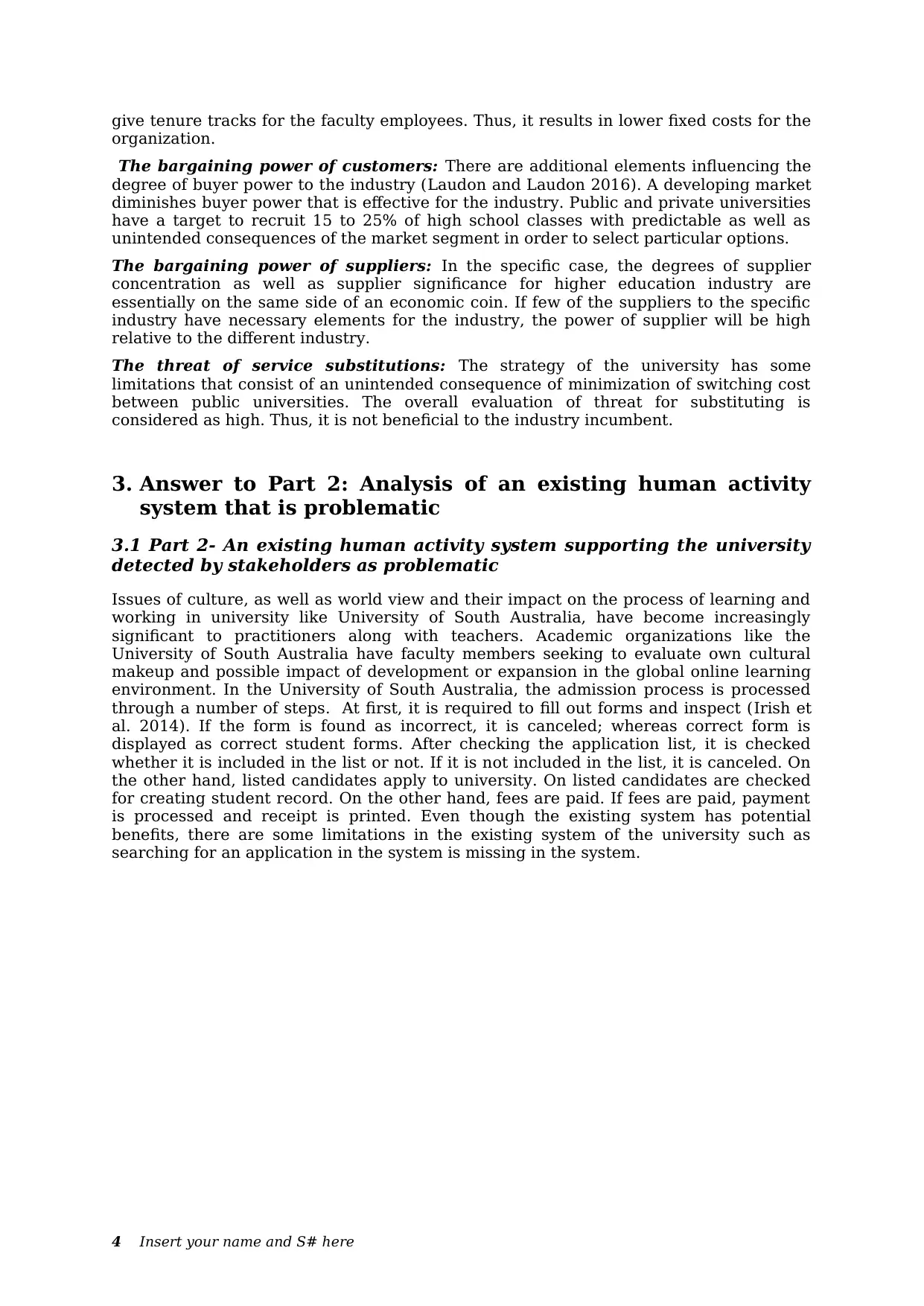
give tenure tracks for the faculty employees. Thus, it results in lower fixed costs for the
organization.
The bargaining power of customers: There are additional elements influencing the
degree of buyer power to the industry (Laudon and Laudon 2016). A developing market
diminishes buyer power that is effective for the industry. Public and private universities
have a target to recruit 15 to 25% of high school classes with predictable as well as
unintended consequences of the market segment in order to select particular options.
The bargaining power of suppliers: In the specific case, the degrees of supplier
concentration as well as supplier significance for higher education industry are
essentially on the same side of an economic coin. If few of the suppliers to the specific
industry have necessary elements for the industry, the power of supplier will be high
relative to the different industry.
The threat of service substitutions: The strategy of the university has some
limitations that consist of an unintended consequence of minimization of switching cost
between public universities. The overall evaluation of threat for substituting is
considered as high. Thus, it is not beneficial to the industry incumbent.
3. Answer to Part 2: Analysis of an existing human activity
system that is problematic
3.1 Part 2- An existing human activity system supporting the university
detected by stakeholders as problematic
Issues of culture, as well as world view and their impact on the process of learning and
working in university like University of South Australia, have become increasingly
significant to practitioners along with teachers. Academic organizations like the
University of South Australia have faculty members seeking to evaluate own cultural
makeup and possible impact of development or expansion in the global online learning
environment. In the University of South Australia, the admission process is processed
through a number of steps. At first, it is required to fill out forms and inspect (Irish et
al. 2014). If the form is found as incorrect, it is canceled; whereas correct form is
displayed as correct student forms. After checking the application list, it is checked
whether it is included in the list or not. If it is not included in the list, it is canceled. On
the other hand, listed candidates apply to university. On listed candidates are checked
for creating student record. On the other hand, fees are paid. If fees are paid, payment
is processed and receipt is printed. Even though the existing system has potential
benefits, there are some limitations in the existing system of the university such as
searching for an application in the system is missing in the system.
4 Insert your name and S# here
organization.
The bargaining power of customers: There are additional elements influencing the
degree of buyer power to the industry (Laudon and Laudon 2016). A developing market
diminishes buyer power that is effective for the industry. Public and private universities
have a target to recruit 15 to 25% of high school classes with predictable as well as
unintended consequences of the market segment in order to select particular options.
The bargaining power of suppliers: In the specific case, the degrees of supplier
concentration as well as supplier significance for higher education industry are
essentially on the same side of an economic coin. If few of the suppliers to the specific
industry have necessary elements for the industry, the power of supplier will be high
relative to the different industry.
The threat of service substitutions: The strategy of the university has some
limitations that consist of an unintended consequence of minimization of switching cost
between public universities. The overall evaluation of threat for substituting is
considered as high. Thus, it is not beneficial to the industry incumbent.
3. Answer to Part 2: Analysis of an existing human activity
system that is problematic
3.1 Part 2- An existing human activity system supporting the university
detected by stakeholders as problematic
Issues of culture, as well as world view and their impact on the process of learning and
working in university like University of South Australia, have become increasingly
significant to practitioners along with teachers. Academic organizations like the
University of South Australia have faculty members seeking to evaluate own cultural
makeup and possible impact of development or expansion in the global online learning
environment. In the University of South Australia, the admission process is processed
through a number of steps. At first, it is required to fill out forms and inspect (Irish et
al. 2014). If the form is found as incorrect, it is canceled; whereas correct form is
displayed as correct student forms. After checking the application list, it is checked
whether it is included in the list or not. If it is not included in the list, it is canceled. On
the other hand, listed candidates apply to university. On listed candidates are checked
for creating student record. On the other hand, fees are paid. If fees are paid, payment
is processed and receipt is printed. Even though the existing system has potential
benefits, there are some limitations in the existing system of the university such as
searching for an application in the system is missing in the system.
4 Insert your name and S# here
Paraphrase This Document
Need a fresh take? Get an instant paraphrase of this document with our AI Paraphraser
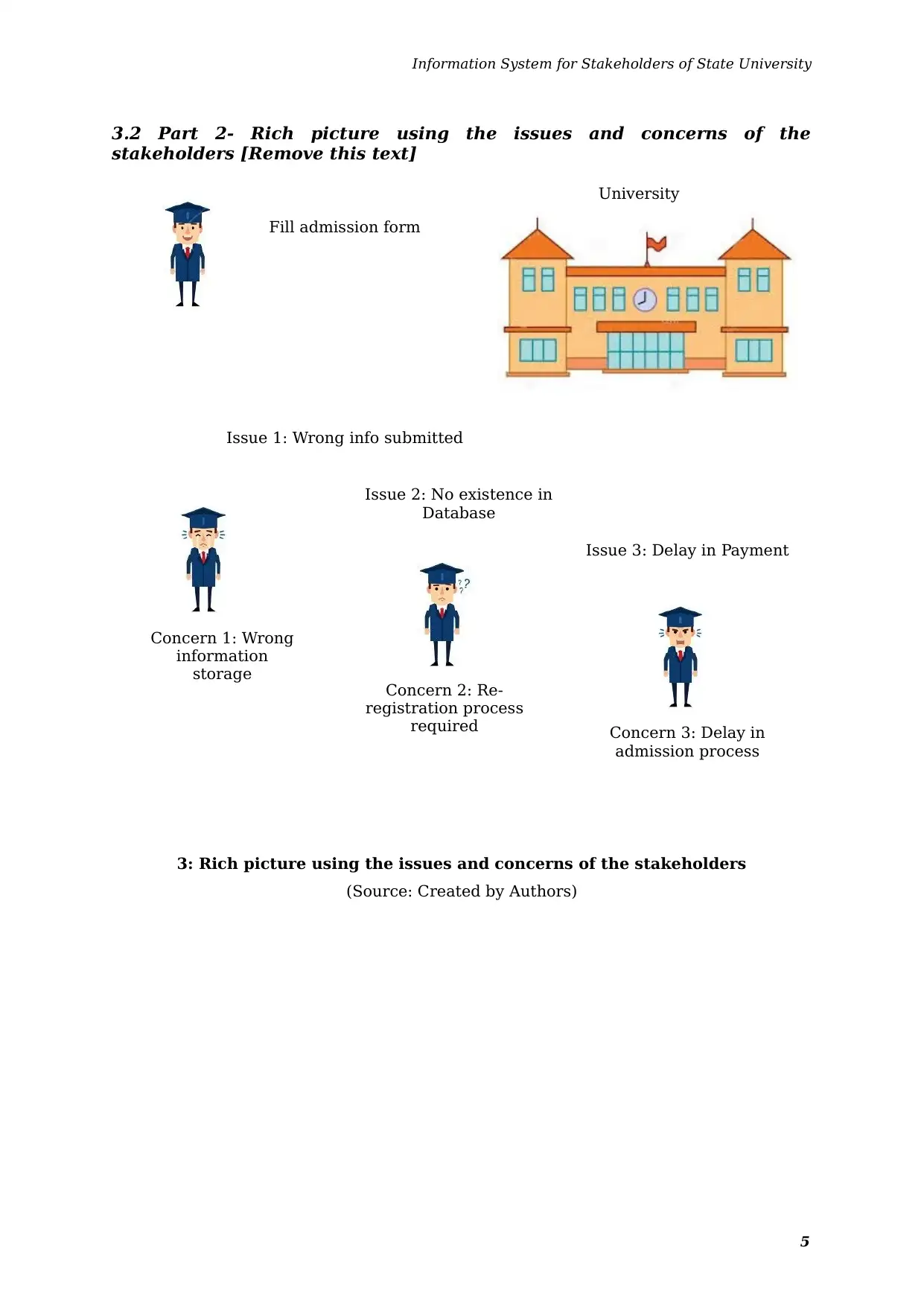
Information System for Stakeholders of State University
3.2 Part 2- Rich picture using the issues and concerns of the
stakeholders [Remove this text]
3: Rich picture using the issues and concerns of the stakeholders
(Source: Created by Authors)
5
Fill admission form
Issue 1: Wrong info submitted
Issue 2: No existence in
Database
Issue 3: Delay in Payment
Concern 1: Wrong
information
storage
Concern 2: Re-
registration process
required Concern 3: Delay in
admission process
University
3.2 Part 2- Rich picture using the issues and concerns of the
stakeholders [Remove this text]
3: Rich picture using the issues and concerns of the stakeholders
(Source: Created by Authors)
5
Fill admission form
Issue 1: Wrong info submitted
Issue 2: No existence in
Database
Issue 3: Delay in Payment
Concern 1: Wrong
information
storage
Concern 2: Re-
registration process
required Concern 3: Delay in
admission process
University
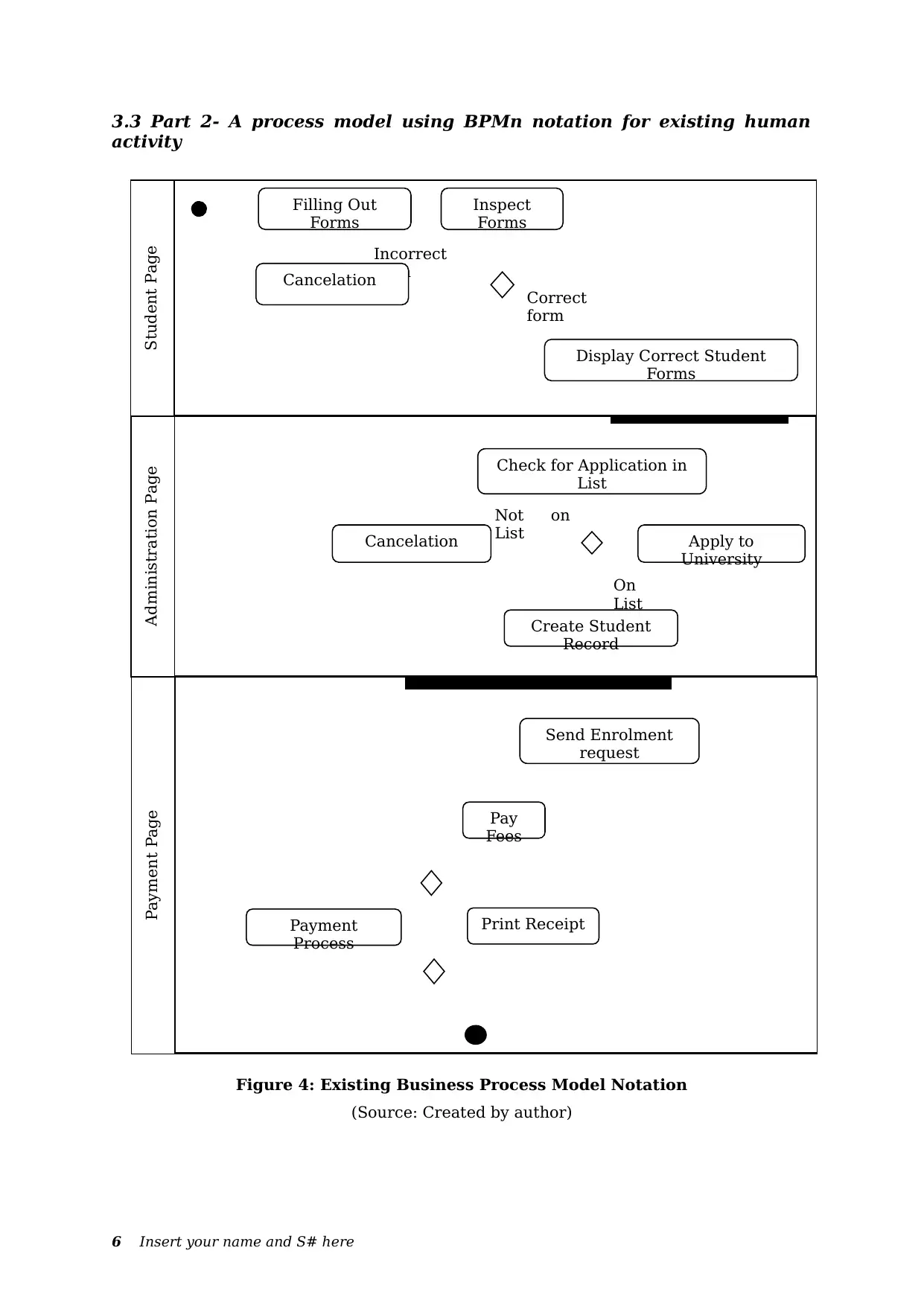
3.3 Part 2- A process model using BPMn notation for existing human
activity
Figure 4: Existing Business Process Model Notation
(Source: Created by author)
6 Insert your name and S# here
Payment Page Administration Page Student Page
Filling Out
Forms
Display Correct Student
Forms
Inspect
Forms
Correct
form
Incorrect
form
Check for Application in
List
Create Student
Record
Apply to
University
Not on
List
On
List
Send Enrolment
request
Pay
Fees
Print ReceiptPayment
Process
Cancelation
Cancelation
activity
Figure 4: Existing Business Process Model Notation
(Source: Created by author)
6 Insert your name and S# here
Payment Page Administration Page Student Page
Filling Out
Forms
Display Correct Student
Forms
Inspect
Forms
Correct
form
Incorrect
form
Check for Application in
List
Create Student
Record
Apply to
University
Not on
List
On
List
Send Enrolment
request
Pay
Fees
Print ReceiptPayment
Process
Cancelation
Cancelation
⊘ This is a preview!⊘
Do you want full access?
Subscribe today to unlock all pages.

Trusted by 1+ million students worldwide

Information System for Stakeholders of State University
3.4 Part 2- The DeLone-McLan model of information system for existing
human activity system
The success model developed by DeLone-McLan has provided a robust indicator of the
success of the information system. There are four conclusions from the research have
been highlighted by them like followed.
There is a broad list of individual variables in order to select from of the
IS researcher.
Important minimization in the number of distinctive dependent variables
measures is required so that the outcome of research can be compared.
There are also some attempts made for measuring the influence of human
activity system on performance of the organization.
Human activity success is considered as a multidimensional construct and
needs to be effectively measured.
With the help of D&M model, success can be measured for the organization. Over the
time, the model can be modified to encounter the needs set by different types of the
information system. DcLone and McLean (2016) can be applied to the present success
model in order to assess the success of human activity system of University of South
Australia. According to the model, information quality, system quality, and service
quality are related to intention to use. The model needs to evaluate the effective process
of learning and efficiency of the employees of the university (De Filippo et al. 2014). On
contrary, user satisfaction is the outcome of information quality and system quality.
Additionally, service quality is also related to satisfaction of the user. Thus, some issues
related to checking of corrected forms are processed along with checking for
application in the specific list. In this perspective, more authentications are required on
it.
3.5 Part 2- Measures of success in terms of efficiency, efficacy, and
effectiveness
The evaluation processes of the human activity system need not large costs or reduction
of quality. It is significant to have adequate and proper knowledge as well as experience
along with technical expertise during deployment of the changes in the organization. It
helps to gain profit from experiences as well as good practices of successful
organization (Hendrick and Kleiner 2016). The enhancement of performance does not
have limitation to implement the process of making changes (Alzahrani et al. 2017). In
addition, the efficiency of the process can be expressed by relative indexes defining the
ratio of real as well as indicators for planning. The International standard can be
defined as the expenses for quality as expenses to ensure satisfactory quality and losses
for inadequate quality (Galliers and Leidner 2014). Hence, for critically evaluating the
effectiveness of the procedure, the relative efficiency and expenses are utilized as two
independent variables.
7
3.4 Part 2- The DeLone-McLan model of information system for existing
human activity system
The success model developed by DeLone-McLan has provided a robust indicator of the
success of the information system. There are four conclusions from the research have
been highlighted by them like followed.
There is a broad list of individual variables in order to select from of the
IS researcher.
Important minimization in the number of distinctive dependent variables
measures is required so that the outcome of research can be compared.
There are also some attempts made for measuring the influence of human
activity system on performance of the organization.
Human activity success is considered as a multidimensional construct and
needs to be effectively measured.
With the help of D&M model, success can be measured for the organization. Over the
time, the model can be modified to encounter the needs set by different types of the
information system. DcLone and McLean (2016) can be applied to the present success
model in order to assess the success of human activity system of University of South
Australia. According to the model, information quality, system quality, and service
quality are related to intention to use. The model needs to evaluate the effective process
of learning and efficiency of the employees of the university (De Filippo et al. 2014). On
contrary, user satisfaction is the outcome of information quality and system quality.
Additionally, service quality is also related to satisfaction of the user. Thus, some issues
related to checking of corrected forms are processed along with checking for
application in the specific list. In this perspective, more authentications are required on
it.
3.5 Part 2- Measures of success in terms of efficiency, efficacy, and
effectiveness
The evaluation processes of the human activity system need not large costs or reduction
of quality. It is significant to have adequate and proper knowledge as well as experience
along with technical expertise during deployment of the changes in the organization. It
helps to gain profit from experiences as well as good practices of successful
organization (Hendrick and Kleiner 2016). The enhancement of performance does not
have limitation to implement the process of making changes (Alzahrani et al. 2017). In
addition, the efficiency of the process can be expressed by relative indexes defining the
ratio of real as well as indicators for planning. The International standard can be
defined as the expenses for quality as expenses to ensure satisfactory quality and losses
for inadequate quality (Galliers and Leidner 2014). Hence, for critically evaluating the
effectiveness of the procedure, the relative efficiency and expenses are utilized as two
independent variables.
7
Paraphrase This Document
Need a fresh take? Get an instant paraphrase of this document with our AI Paraphraser
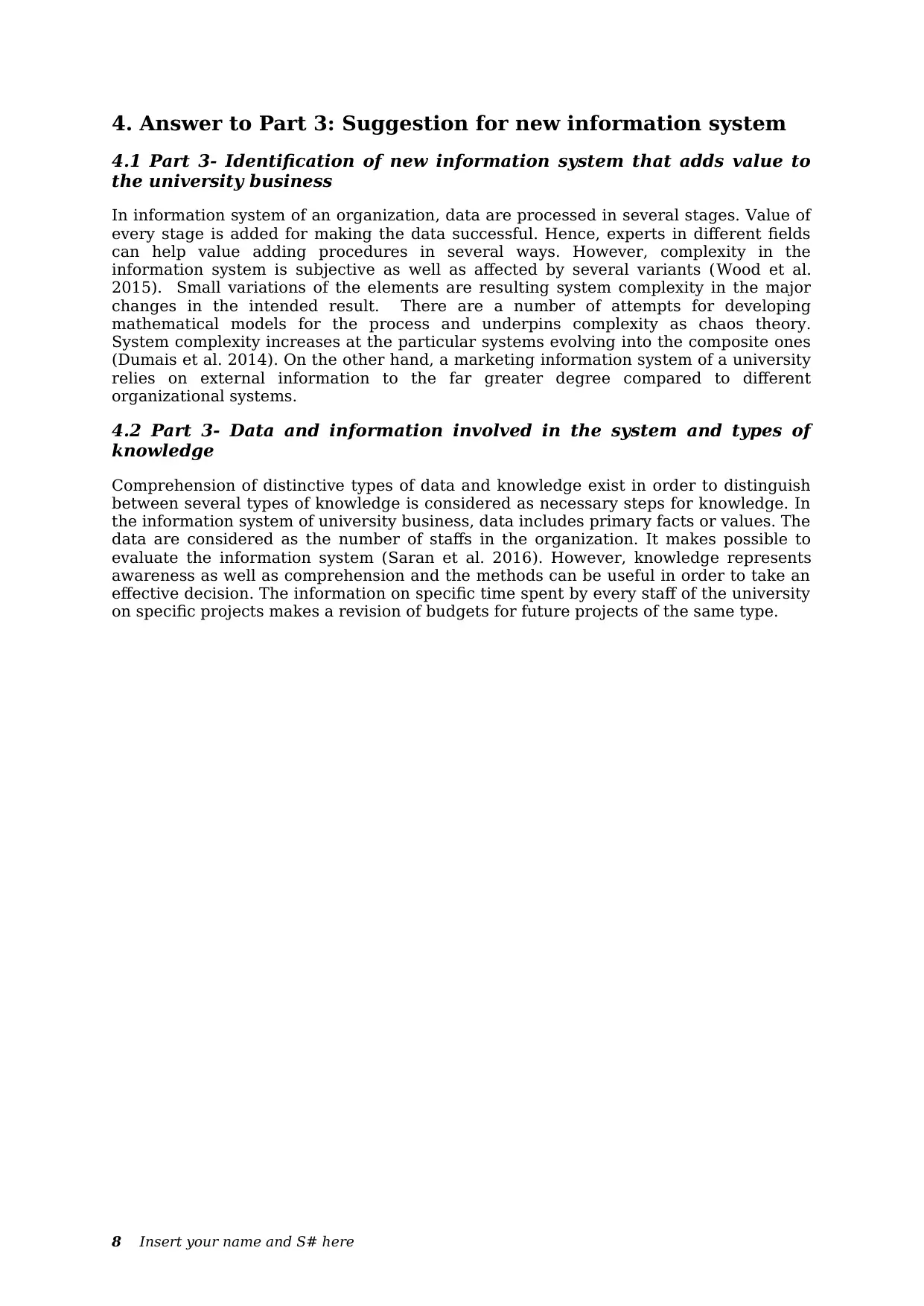
4. Answer to Part 3: Suggestion for new information system
4.1 Part 3- Identification of new information system that adds value to
the university business
In information system of an organization, data are processed in several stages. Value of
every stage is added for making the data successful. Hence, experts in different fields
can help value adding procedures in several ways. However, complexity in the
information system is subjective as well as affected by several variants (Wood et al.
2015). Small variations of the elements are resulting system complexity in the major
changes in the intended result. There are a number of attempts for developing
mathematical models for the process and underpins complexity as chaos theory.
System complexity increases at the particular systems evolving into the composite ones
(Dumais et al. 2014). On the other hand, a marketing information system of a university
relies on external information to the far greater degree compared to different
organizational systems.
4.2 Part 3- Data and information involved in the system and types of
knowledge
Comprehension of distinctive types of data and knowledge exist in order to distinguish
between several types of knowledge is considered as necessary steps for knowledge. In
the information system of university business, data includes primary facts or values. The
data are considered as the number of staffs in the organization. It makes possible to
evaluate the information system (Saran et al. 2016). However, knowledge represents
awareness as well as comprehension and the methods can be useful in order to take an
effective decision. The information on specific time spent by every staff of the university
on specific projects makes a revision of budgets for future projects of the same type.
8 Insert your name and S# here
4.1 Part 3- Identification of new information system that adds value to
the university business
In information system of an organization, data are processed in several stages. Value of
every stage is added for making the data successful. Hence, experts in different fields
can help value adding procedures in several ways. However, complexity in the
information system is subjective as well as affected by several variants (Wood et al.
2015). Small variations of the elements are resulting system complexity in the major
changes in the intended result. There are a number of attempts for developing
mathematical models for the process and underpins complexity as chaos theory.
System complexity increases at the particular systems evolving into the composite ones
(Dumais et al. 2014). On the other hand, a marketing information system of a university
relies on external information to the far greater degree compared to different
organizational systems.
4.2 Part 3- Data and information involved in the system and types of
knowledge
Comprehension of distinctive types of data and knowledge exist in order to distinguish
between several types of knowledge is considered as necessary steps for knowledge. In
the information system of university business, data includes primary facts or values. The
data are considered as the number of staffs in the organization. It makes possible to
evaluate the information system (Saran et al. 2016). However, knowledge represents
awareness as well as comprehension and the methods can be useful in order to take an
effective decision. The information on specific time spent by every staff of the university
on specific projects makes a revision of budgets for future projects of the same type.
8 Insert your name and S# here
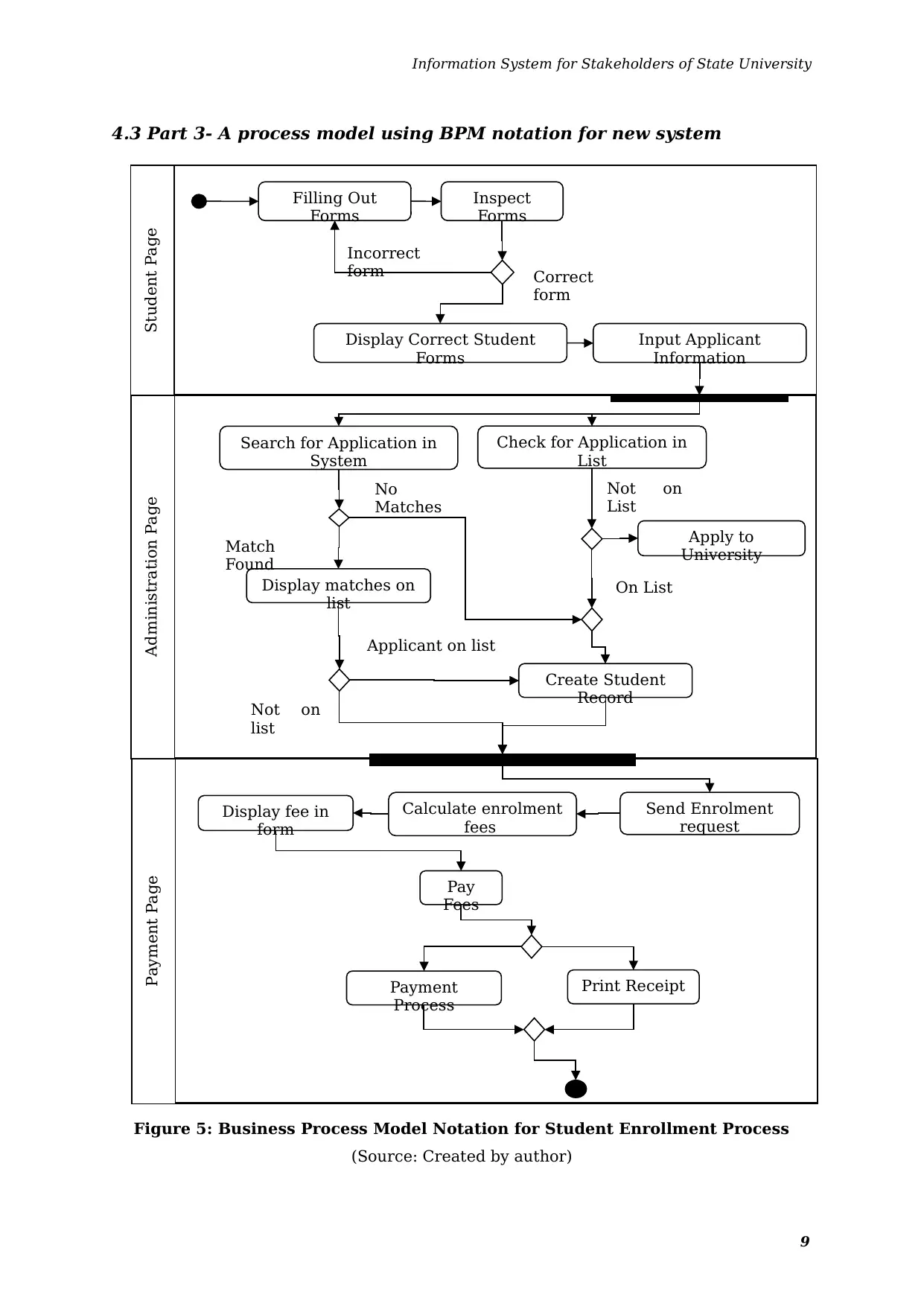
Information System for Stakeholders of State University
4.3 Part 3- A process model using BPM notation for new system
Figure 5: Business Process Model Notation for Student Enrollment Process
(Source: Created by author)
9
Payment Page Administration Page Student Page
Filling Out
Forms
Display Correct Student
Forms
Input Applicant
Information
Inspect
Forms
Correct
form
Incorrect
form
Check for Application in
List
Search for Application in
System
Display matches on
list
Create Student
Record
Apply to
University
Not on
List
On List
No
Matches
Match
Found
Applicant on list
Not on
list
Send Enrolment
request
Calculate enrolment
fees
Pay
Fees
Print Receipt
Display fee in
form
Payment
Process
4.3 Part 3- A process model using BPM notation for new system
Figure 5: Business Process Model Notation for Student Enrollment Process
(Source: Created by author)
9
Payment Page Administration Page Student Page
Filling Out
Forms
Display Correct Student
Forms
Input Applicant
Information
Inspect
Forms
Correct
form
Incorrect
form
Check for Application in
List
Search for Application in
System
Display matches on
list
Create Student
Record
Apply to
University
Not on
List
On List
No
Matches
Match
Found
Applicant on list
Not on
list
Send Enrolment
request
Calculate enrolment
fees
Pay
Fees
Print Receipt
Display fee in
form
Payment
Process
⊘ This is a preview!⊘
Do you want full access?
Subscribe today to unlock all pages.

Trusted by 1+ million students worldwide

4.4 Part 3- Classification of new information system within the university
In dealing with the issues engaged in comprehension of complicated systems, it would
be useful to consider various distinctive perspective of a complicated system. Three
foundational perspectives of multifaceted as well as hierarchical system are considered
as synoptic and structural perspective (Biasini et al. 2014). Development of three views
of human activity system can provide valuable advice to an enterprise seeking for
human activity system gives valuable advice to the university seeking for evaluating
own cultural makeup as well as possible impact of the activity on development (Eveland
and Dunwoody 2016). There are distinctive types of information system like transaction
processing system, system for decision support, learning management systems,
knowledge management system and office information system as well as database
management system, which are implemented as new information system for the
university.
4.5 Part 3- Dimensions of impact proposed to the new information
system
It is crucial to focus on the particular system and find the key values. In the present
system, new information system needs to be identified. There is search option for the
application in the system along with check for application in list. In addition, display
matches on the list are identified (Enck et al. 2014). On the other hand, information is
the collection of facts that are organized so that additional value can be added.
Information gives a context of the data as well as assists to identify the issues.
Additionally, checking for application in the list is further processing to application to
the university. The system would be helpful for overall information system in the
organization. It would be helpful to bring effectiveness of the staffs and make fast
process (Aiken et al. 2014). On the other hand, fewer errors in the information system
would be helpful for the stakeholders to involve in the system.
4.6 Part 3- The measures of success of new information system
The process of calculating evaluation criteria needs to be effectively estimated. Hence,
it is essential to determine whether the relative efficiency and relative expenses can be
defined as the process. Effective management of the organization is essential
precondition for the organization not to survive and competitive in the market to be
developed. One of the ways to process effective enterprise management is to enhance
effectiveness of management that needs to be properly processed in the university
(Sanjana et al. 2014). It is important to take into account that selection of performance
management systems is considered as individual process of the organization. Hence, it
is important to take necessary action regarding the issue that is presented in the new
information system.
5. Answer to Part 4: Recommendations and reflection
Management of information system is considered as important in a university. Hence,
the standards need to be implemented and confirm the high level of the system and
ensure efficiency as well as success (Acland et al. 2014). It is necessary that the new
information system will bring tangent advantages as well as results of efficiency
measurement. Moreover, it is important to provide extra material used for developing
strategic planning for the particular organization. On the other hand, when assessing
the specific criteria of quality as well as costs, it is important to set up the accurate
statistical relationship between the relative efficiency of criteria and relative expenses.
In addition, the estimated value needs to be matched with the correlation that shows
medium strength. It is vital to develop real conformity of performance that can be
processed by the institution. As per the analysis, theoretical data, as well as empirical
research, can be helpful to the process of assessment of the effectiveness of
implemented quality management system included in the university (Kim et al. 2015).
Hence, the proposal of new information system would be helpful to the organization to
bring effectiveness in the process.
10 Insert your name and S# here
In dealing with the issues engaged in comprehension of complicated systems, it would
be useful to consider various distinctive perspective of a complicated system. Three
foundational perspectives of multifaceted as well as hierarchical system are considered
as synoptic and structural perspective (Biasini et al. 2014). Development of three views
of human activity system can provide valuable advice to an enterprise seeking for
human activity system gives valuable advice to the university seeking for evaluating
own cultural makeup as well as possible impact of the activity on development (Eveland
and Dunwoody 2016). There are distinctive types of information system like transaction
processing system, system for decision support, learning management systems,
knowledge management system and office information system as well as database
management system, which are implemented as new information system for the
university.
4.5 Part 3- Dimensions of impact proposed to the new information
system
It is crucial to focus on the particular system and find the key values. In the present
system, new information system needs to be identified. There is search option for the
application in the system along with check for application in list. In addition, display
matches on the list are identified (Enck et al. 2014). On the other hand, information is
the collection of facts that are organized so that additional value can be added.
Information gives a context of the data as well as assists to identify the issues.
Additionally, checking for application in the list is further processing to application to
the university. The system would be helpful for overall information system in the
organization. It would be helpful to bring effectiveness of the staffs and make fast
process (Aiken et al. 2014). On the other hand, fewer errors in the information system
would be helpful for the stakeholders to involve in the system.
4.6 Part 3- The measures of success of new information system
The process of calculating evaluation criteria needs to be effectively estimated. Hence,
it is essential to determine whether the relative efficiency and relative expenses can be
defined as the process. Effective management of the organization is essential
precondition for the organization not to survive and competitive in the market to be
developed. One of the ways to process effective enterprise management is to enhance
effectiveness of management that needs to be properly processed in the university
(Sanjana et al. 2014). It is important to take into account that selection of performance
management systems is considered as individual process of the organization. Hence, it
is important to take necessary action regarding the issue that is presented in the new
information system.
5. Answer to Part 4: Recommendations and reflection
Management of information system is considered as important in a university. Hence,
the standards need to be implemented and confirm the high level of the system and
ensure efficiency as well as success (Acland et al. 2014). It is necessary that the new
information system will bring tangent advantages as well as results of efficiency
measurement. Moreover, it is important to provide extra material used for developing
strategic planning for the particular organization. On the other hand, when assessing
the specific criteria of quality as well as costs, it is important to set up the accurate
statistical relationship between the relative efficiency of criteria and relative expenses.
In addition, the estimated value needs to be matched with the correlation that shows
medium strength. It is vital to develop real conformity of performance that can be
processed by the institution. As per the analysis, theoretical data, as well as empirical
research, can be helpful to the process of assessment of the effectiveness of
implemented quality management system included in the university (Kim et al. 2015).
Hence, the proposal of new information system would be helpful to the organization to
bring effectiveness in the process.
10 Insert your name and S# here
Paraphrase This Document
Need a fresh take? Get an instant paraphrase of this document with our AI Paraphraser
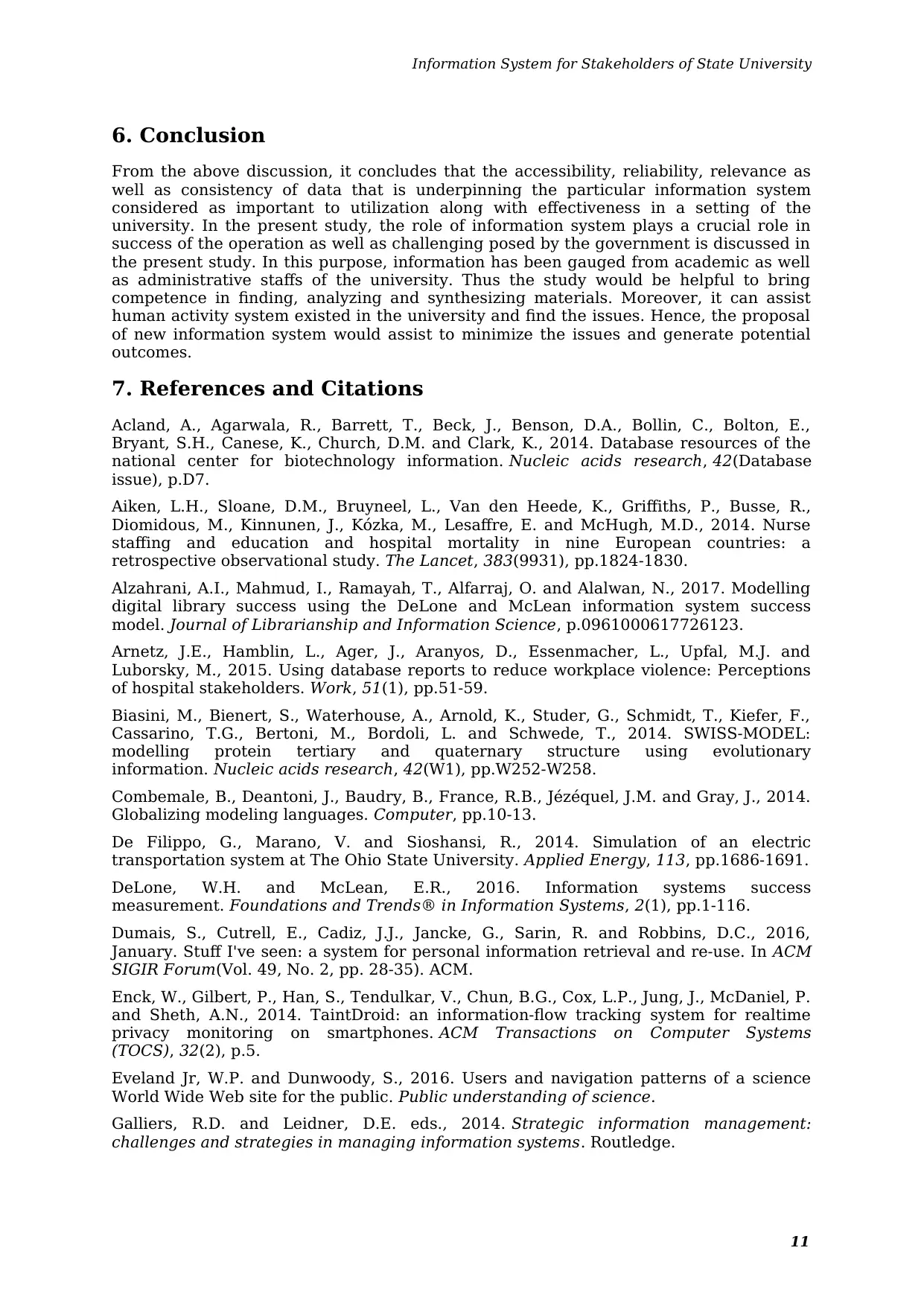
Information System for Stakeholders of State University
6. Conclusion
From the above discussion, it concludes that the accessibility, reliability, relevance as
well as consistency of data that is underpinning the particular information system
considered as important to utilization along with effectiveness in a setting of the
university. In the present study, the role of information system plays a crucial role in
success of the operation as well as challenging posed by the government is discussed in
the present study. In this purpose, information has been gauged from academic as well
as administrative staffs of the university. Thus the study would be helpful to bring
competence in finding, analyzing and synthesizing materials. Moreover, it can assist
human activity system existed in the university and find the issues. Hence, the proposal
of new information system would assist to minimize the issues and generate potential
outcomes.
7. References and Citations
Acland, A., Agarwala, R., Barrett, T., Beck, J., Benson, D.A., Bollin, C., Bolton, E.,
Bryant, S.H., Canese, K., Church, D.M. and Clark, K., 2014. Database resources of the
national center for biotechnology information. Nucleic acids research, 42(Database
issue), p.D7.
Aiken, L.H., Sloane, D.M., Bruyneel, L., Van den Heede, K., Griffiths, P., Busse, R.,
Diomidous, M., Kinnunen, J., Kózka, M., Lesaffre, E. and McHugh, M.D., 2014. Nurse
staffing and education and hospital mortality in nine European countries: a
retrospective observational study. The Lancet, 383(9931), pp.1824-1830.
Alzahrani, A.I., Mahmud, I., Ramayah, T., Alfarraj, O. and Alalwan, N., 2017. Modelling
digital library success using the DeLone and McLean information system success
model. Journal of Librarianship and Information Science, p.0961000617726123.
Arnetz, J.E., Hamblin, L., Ager, J., Aranyos, D., Essenmacher, L., Upfal, M.J. and
Luborsky, M., 2015. Using database reports to reduce workplace violence: Perceptions
of hospital stakeholders. Work, 51(1), pp.51-59.
Biasini, M., Bienert, S., Waterhouse, A., Arnold, K., Studer, G., Schmidt, T., Kiefer, F.,
Cassarino, T.G., Bertoni, M., Bordoli, L. and Schwede, T., 2014. SWISS-MODEL:
modelling protein tertiary and quaternary structure using evolutionary
information. Nucleic acids research, 42(W1), pp.W252-W258.
Combemale, B., Deantoni, J., Baudry, B., France, R.B., Jézéquel, J.M. and Gray, J., 2014.
Globalizing modeling languages. Computer, pp.10-13.
De Filippo, G., Marano, V. and Sioshansi, R., 2014. Simulation of an electric
transportation system at The Ohio State University. Applied Energy, 113, pp.1686-1691.
DeLone, W.H. and McLean, E.R., 2016. Information systems success
measurement. Foundations and Trends® in Information Systems, 2(1), pp.1-116.
Dumais, S., Cutrell, E., Cadiz, J.J., Jancke, G., Sarin, R. and Robbins, D.C., 2016,
January. Stuff I've seen: a system for personal information retrieval and re-use. In ACM
SIGIR Forum(Vol. 49, No. 2, pp. 28-35). ACM.
Enck, W., Gilbert, P., Han, S., Tendulkar, V., Chun, B.G., Cox, L.P., Jung, J., McDaniel, P.
and Sheth, A.N., 2014. TaintDroid: an information-flow tracking system for realtime
privacy monitoring on smartphones. ACM Transactions on Computer Systems
(TOCS), 32(2), p.5.
Eveland Jr, W.P. and Dunwoody, S., 2016. Users and navigation patterns of a science
World Wide Web site for the public. Public understanding of science.
Galliers, R.D. and Leidner, D.E. eds., 2014. Strategic information management:
challenges and strategies in managing information systems. Routledge.
11
6. Conclusion
From the above discussion, it concludes that the accessibility, reliability, relevance as
well as consistency of data that is underpinning the particular information system
considered as important to utilization along with effectiveness in a setting of the
university. In the present study, the role of information system plays a crucial role in
success of the operation as well as challenging posed by the government is discussed in
the present study. In this purpose, information has been gauged from academic as well
as administrative staffs of the university. Thus the study would be helpful to bring
competence in finding, analyzing and synthesizing materials. Moreover, it can assist
human activity system existed in the university and find the issues. Hence, the proposal
of new information system would assist to minimize the issues and generate potential
outcomes.
7. References and Citations
Acland, A., Agarwala, R., Barrett, T., Beck, J., Benson, D.A., Bollin, C., Bolton, E.,
Bryant, S.H., Canese, K., Church, D.M. and Clark, K., 2014. Database resources of the
national center for biotechnology information. Nucleic acids research, 42(Database
issue), p.D7.
Aiken, L.H., Sloane, D.M., Bruyneel, L., Van den Heede, K., Griffiths, P., Busse, R.,
Diomidous, M., Kinnunen, J., Kózka, M., Lesaffre, E. and McHugh, M.D., 2014. Nurse
staffing and education and hospital mortality in nine European countries: a
retrospective observational study. The Lancet, 383(9931), pp.1824-1830.
Alzahrani, A.I., Mahmud, I., Ramayah, T., Alfarraj, O. and Alalwan, N., 2017. Modelling
digital library success using the DeLone and McLean information system success
model. Journal of Librarianship and Information Science, p.0961000617726123.
Arnetz, J.E., Hamblin, L., Ager, J., Aranyos, D., Essenmacher, L., Upfal, M.J. and
Luborsky, M., 2015. Using database reports to reduce workplace violence: Perceptions
of hospital stakeholders. Work, 51(1), pp.51-59.
Biasini, M., Bienert, S., Waterhouse, A., Arnold, K., Studer, G., Schmidt, T., Kiefer, F.,
Cassarino, T.G., Bertoni, M., Bordoli, L. and Schwede, T., 2014. SWISS-MODEL:
modelling protein tertiary and quaternary structure using evolutionary
information. Nucleic acids research, 42(W1), pp.W252-W258.
Combemale, B., Deantoni, J., Baudry, B., France, R.B., Jézéquel, J.M. and Gray, J., 2014.
Globalizing modeling languages. Computer, pp.10-13.
De Filippo, G., Marano, V. and Sioshansi, R., 2014. Simulation of an electric
transportation system at The Ohio State University. Applied Energy, 113, pp.1686-1691.
DeLone, W.H. and McLean, E.R., 2016. Information systems success
measurement. Foundations and Trends® in Information Systems, 2(1), pp.1-116.
Dumais, S., Cutrell, E., Cadiz, J.J., Jancke, G., Sarin, R. and Robbins, D.C., 2016,
January. Stuff I've seen: a system for personal information retrieval and re-use. In ACM
SIGIR Forum(Vol. 49, No. 2, pp. 28-35). ACM.
Enck, W., Gilbert, P., Han, S., Tendulkar, V., Chun, B.G., Cox, L.P., Jung, J., McDaniel, P.
and Sheth, A.N., 2014. TaintDroid: an information-flow tracking system for realtime
privacy monitoring on smartphones. ACM Transactions on Computer Systems
(TOCS), 32(2), p.5.
Eveland Jr, W.P. and Dunwoody, S., 2016. Users and navigation patterns of a science
World Wide Web site for the public. Public understanding of science.
Galliers, R.D. and Leidner, D.E. eds., 2014. Strategic information management:
challenges and strategies in managing information systems. Routledge.
11
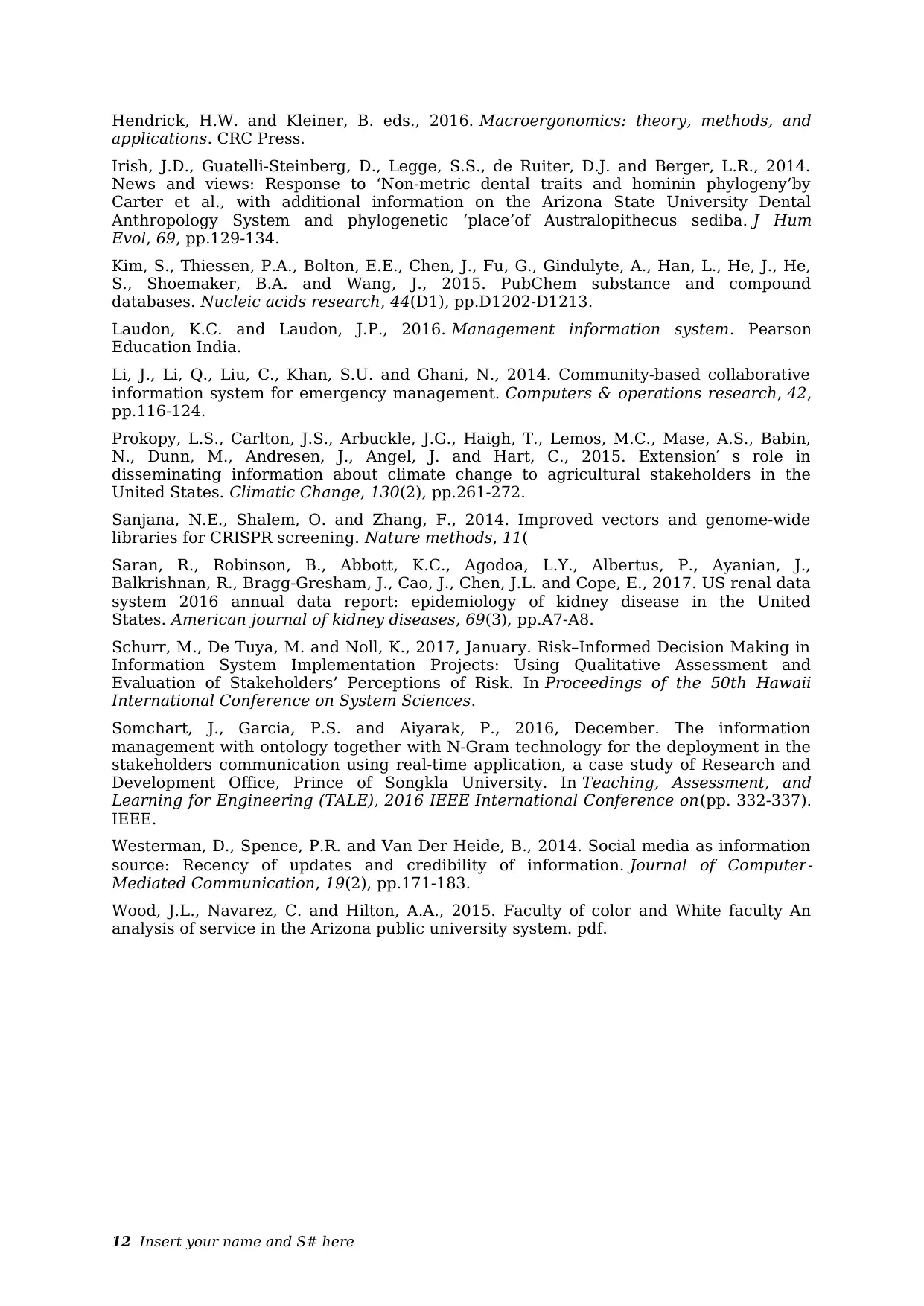
Hendrick, H.W. and Kleiner, B. eds., 2016. Macroergonomics: theory, methods, and
applications. CRC Press.
Irish, J.D., Guatelli-Steinberg, D., Legge, S.S., de Ruiter, D.J. and Berger, L.R., 2014.
News and views: Response to ‘Non-metric dental traits and hominin phylogeny’by
Carter et al., with additional information on the Arizona State University Dental
Anthropology System and phylogenetic ‘place’of Australopithecus sediba. J Hum
Evol, 69, pp.129-134.
Kim, S., Thiessen, P.A., Bolton, E.E., Chen, J., Fu, G., Gindulyte, A., Han, L., He, J., He,
S., Shoemaker, B.A. and Wang, J., 2015. PubChem substance and compound
databases. Nucleic acids research, 44(D1), pp.D1202-D1213.
Laudon, K.C. and Laudon, J.P., 2016. Management information system. Pearson
Education India.
Li, J., Li, Q., Liu, C., Khan, S.U. and Ghani, N., 2014. Community-based collaborative
information system for emergency management. Computers & operations research, 42,
pp.116-124.
Prokopy, L.S., Carlton, J.S., Arbuckle, J.G., Haigh, T., Lemos, M.C., Mase, A.S., Babin,
N., Dunn, M., Andresen, J., Angel, J. and Hart, C., 2015. Extension′ s role in
disseminating information about climate change to agricultural stakeholders in the
United States. Climatic Change, 130(2), pp.261-272.
Sanjana, N.E., Shalem, O. and Zhang, F., 2014. Improved vectors and genome-wide
libraries for CRISPR screening. Nature methods, 11(
Saran, R., Robinson, B., Abbott, K.C., Agodoa, L.Y., Albertus, P., Ayanian, J.,
Balkrishnan, R., Bragg-Gresham, J., Cao, J., Chen, J.L. and Cope, E., 2017. US renal data
system 2016 annual data report: epidemiology of kidney disease in the United
States. American journal of kidney diseases, 69(3), pp.A7-A8.
Schurr, M., De Tuya, M. and Noll, K., 2017, January. Risk–Informed Decision Making in
Information System Implementation Projects: Using Qualitative Assessment and
Evaluation of Stakeholders’ Perceptions of Risk. In Proceedings of the 50th Hawaii
International Conference on System Sciences.
Somchart, J., Garcia, P.S. and Aiyarak, P., 2016, December. The information
management with ontology together with N-Gram technology for the deployment in the
stakeholders communication using real-time application, a case study of Research and
Development Office, Prince of Songkla University. In Teaching, Assessment, and
Learning for Engineering (TALE), 2016 IEEE International Conference on(pp. 332-337).
IEEE.
Westerman, D., Spence, P.R. and Van Der Heide, B., 2014. Social media as information
source: Recency of updates and credibility of information. Journal of Computer
‐
Mediated Communication, 19(2), pp.171-183.
Wood, J.L., Navarez, C. and Hilton, A.A., 2015. Faculty of color and White faculty An
analysis of service in the Arizona public university system. pdf.
12 Insert your name and S# here
applications. CRC Press.
Irish, J.D., Guatelli-Steinberg, D., Legge, S.S., de Ruiter, D.J. and Berger, L.R., 2014.
News and views: Response to ‘Non-metric dental traits and hominin phylogeny’by
Carter et al., with additional information on the Arizona State University Dental
Anthropology System and phylogenetic ‘place’of Australopithecus sediba. J Hum
Evol, 69, pp.129-134.
Kim, S., Thiessen, P.A., Bolton, E.E., Chen, J., Fu, G., Gindulyte, A., Han, L., He, J., He,
S., Shoemaker, B.A. and Wang, J., 2015. PubChem substance and compound
databases. Nucleic acids research, 44(D1), pp.D1202-D1213.
Laudon, K.C. and Laudon, J.P., 2016. Management information system. Pearson
Education India.
Li, J., Li, Q., Liu, C., Khan, S.U. and Ghani, N., 2014. Community-based collaborative
information system for emergency management. Computers & operations research, 42,
pp.116-124.
Prokopy, L.S., Carlton, J.S., Arbuckle, J.G., Haigh, T., Lemos, M.C., Mase, A.S., Babin,
N., Dunn, M., Andresen, J., Angel, J. and Hart, C., 2015. Extension′ s role in
disseminating information about climate change to agricultural stakeholders in the
United States. Climatic Change, 130(2), pp.261-272.
Sanjana, N.E., Shalem, O. and Zhang, F., 2014. Improved vectors and genome-wide
libraries for CRISPR screening. Nature methods, 11(
Saran, R., Robinson, B., Abbott, K.C., Agodoa, L.Y., Albertus, P., Ayanian, J.,
Balkrishnan, R., Bragg-Gresham, J., Cao, J., Chen, J.L. and Cope, E., 2017. US renal data
system 2016 annual data report: epidemiology of kidney disease in the United
States. American journal of kidney diseases, 69(3), pp.A7-A8.
Schurr, M., De Tuya, M. and Noll, K., 2017, January. Risk–Informed Decision Making in
Information System Implementation Projects: Using Qualitative Assessment and
Evaluation of Stakeholders’ Perceptions of Risk. In Proceedings of the 50th Hawaii
International Conference on System Sciences.
Somchart, J., Garcia, P.S. and Aiyarak, P., 2016, December. The information
management with ontology together with N-Gram technology for the deployment in the
stakeholders communication using real-time application, a case study of Research and
Development Office, Prince of Songkla University. In Teaching, Assessment, and
Learning for Engineering (TALE), 2016 IEEE International Conference on(pp. 332-337).
IEEE.
Westerman, D., Spence, P.R. and Van Der Heide, B., 2014. Social media as information
source: Recency of updates and credibility of information. Journal of Computer
‐
Mediated Communication, 19(2), pp.171-183.
Wood, J.L., Navarez, C. and Hilton, A.A., 2015. Faculty of color and White faculty An
analysis of service in the Arizona public university system. pdf.
12 Insert your name and S# here
⊘ This is a preview!⊘
Do you want full access?
Subscribe today to unlock all pages.

Trusted by 1+ million students worldwide
1 out of 12
Related Documents
Your All-in-One AI-Powered Toolkit for Academic Success.
+13062052269
info@desklib.com
Available 24*7 on WhatsApp / Email
![[object Object]](/_next/static/media/star-bottom.7253800d.svg)
Unlock your academic potential
Copyright © 2020–2025 A2Z Services. All Rights Reserved. Developed and managed by ZUCOL.




